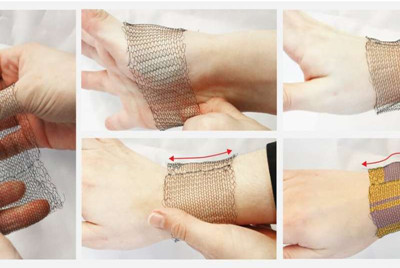
A breakthrough invention in wearable technology has the potential to change how we interact with the clothes we wear every day.
A new study led by researchers at the University of Minnesota's Design of Active Materials and Structures Lab (DAMSL) and Wearable Technology Lab (WTL) details the development of a temperature-responsive textile that can be used to create self-fitting garments powered only by body heat. The study, led by graduate students Kevin Eschen and Rachael Granberry and professors Julianna Abel and Brad Holschuh was recently published in Advanced Materials Technologies.
"This is an important step forward in the creation of robotic textiles for on-body applications," said Holschuh. "It's particularly exciting because it solves two significant problems simultaneously: how to create usable actuation, or movement, without requiring significant power or heat, and how to conform a textile or garment to regions of the body that are irregularly shaped."
The textiles resemble typical knits, except they are created using a special category of active materials—known as shape memory alloys (SMAs)—which change shape when heated.
In partnership with NASA, U of M researchers studied the unique dimensions of a human leg. They then subsequently designed, manufactured and tested an SMA-based knitted garment that can precisely conform to a leg's topography.
"This technology required advancements on multiple scales," said Abel. "At the material scale, we tuned it to respond to body temperature without added power. Structurally, we manufactured it to adapt to the complex shapes of the human body perfectly. At the system level, we created an operation that maps the mechanical performance of textiles to human anatomy. Each advancement is important, but, together, they create a functionality that didn't exist before."
These knits can be used in custom garments that can easily transform from loose to tight-fitting, and even bend in unique ways to conform to irregularly shaped regions of the body (e.g., the back of the knee). Examples of future use could be to create compression garments that are initially loose fitting and easy to put on which could subsequently shrink to tightly squeeze the wearer.
"This creates an exciting new opportunity to create garments that can physically transform over time, which has significant implications for medical, aerospace and commercial applications," Holschuh said.
Next steps will be to integrate the textiles into full-sized garments, which could solve a variety of problems where fit and conformance to the body are important, such as medical-grade compression stockings.

